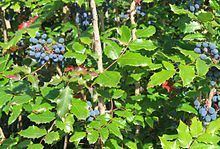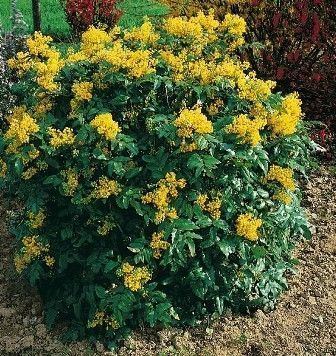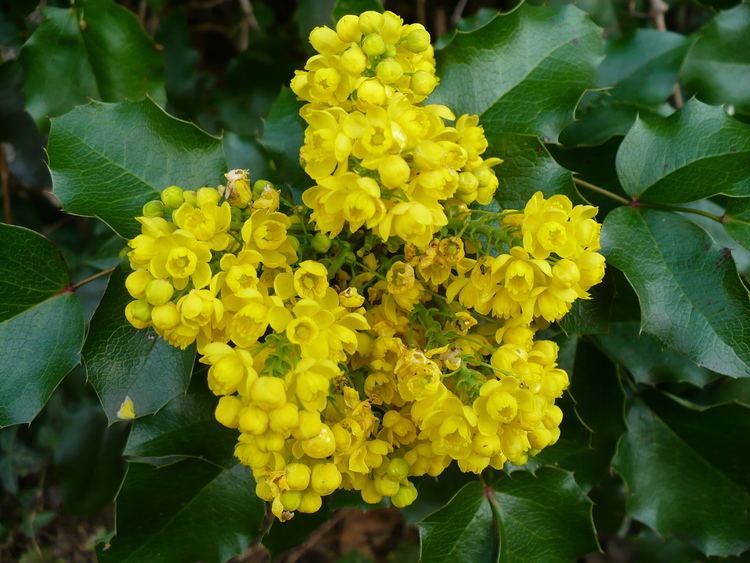Kingdom Plantae Family Berberidaceae Scientific name Mahonia aquifolium Rank Species | Order Ranunculales Genus Mahonia Higher classification Barberry Symbol of Oregon | |
 | ||
Similar Berry, Shadbush, Silverberry, Arctostaphylos, Salmonberry | ||
Tall oragon grape mahonia aquifolium barberidaceae teds outdoors h s
Mahonia aquifolium (Oregon-grape or Oregon grape) is a species of flowering plant in the family Berberidaceae, native to western North America. It is an evergreen shrub growing to 1 m (3 ft) tall by 1.5 m (5 ft) wide, with pinnate leaves consisting of spiny leaflets, and dense clusters of yellow flowers in early spring, followed by dark bluish-black berries.
Contents
- Tall oragon grape mahonia aquifolium barberidaceae teds outdoors h s
- Mahonia aquifolium kerria plant broddur mahon runnar gar sk lapl ntur gar yrkja
- Etymology
- Description
- Taxonomy
- Distribution
- Cultivation
- Other uses
- Herbal medicine
- Chemical constituents
- Culture
- References

Mahonia aquifolium kerria plant broddur mahon runnar gar sk lapl ntur gar yrkja
Etymology
The specific epithet aquifolium means "holly-leaved", referring to the spiny foliage. The common name is often (always in the UK) left un-hyphenated as Oregon grape, though doing so invites confusion with the true grapes. Some writers avoid this confusion by using "Oregon grape-holly", or "Oregon holly-grape" as a vernacular name for any species of mahonia. It also occasionally appears in print as Oregongrape. There are several common species of Oregon-grape, many with numerous cultivated varieties (cultivars). Among these are tall Oregon grape (Mahonia aquifolium); Cascade, low, dull, or dwarf Oregon grape (M. nervosa); and creeping Oregon grape (M. repens).
Description

Mahonia aquifolium grows to 1–2 m (3 ft 3 in–6 ft 7 in) tall by 1.5 m (5 ft) wide, with pinnate leaves up to 30 cm (12 in) long, each leaf made up of spiny leaflets. The leathery leaves resemble holly and the stems and twigs have a thickened, corky appearance. The flowers, borne in dense clusters in late spring, are yellow, and are followed by spherical dark dusty blue berries, which give rise to the common name "Oregon grape".
Taxonomy

Some authors place Mahonia in the barberry genus, Berberis. The Oregon-grape is not related to true grapes, but gets its name from the purple clusters of berries whose color and slightly dusted appearance are reminiscent of grapes.
Distribution

Mahonia aquifolium is a native plant in the North American West from Southeast Alaska to Northern California, and eastern Alberta to central New Mexico, often occurring in the understory of Douglas-fir forests (although other forest types contain the species) and in brushlands in the Cascades, Rockies, and northern Sierras.

In some areas outside its native range, M. aquifolium has been classified as an invasive exotic species that may displace native vegetation.
Cultivation

Mahonia aquifolium is a popular subject in shady or woodland plantings. It is valued for its striking foliage and flowers, which often appear before those of other shrubs. It is resistant to summer drought, tolerates poor soils, and does not create excessive leaf litter. Its berries attract birds.
Numerous cultivars and hybrids have been developed, of which the following have gained the Royal Horticultural Society's Award of Garden Merit:
Other uses
The small purplish-black fruits, which are quite tart and contain large seeds, are included in smaller quantities in the traditional diets of Pacific Northwest aboriginal peoples, mixed with Salal or another sweeter fruit. Today they are sometimes used to make jelly, alone or mixed with salal. Oregon grape juice can be fermented to make wine, similar to European barberry wine folk traditions, although it requires an unusually high amount of sugar. The inner bark of the larger stems and roots of Oregon-grape yield a yellow dye; the berries give purple dye. As the leaves of Oregon-grape are holly-like and resist wilting, the foliage is sometimes used by florists for greenery and a small gathering industry has been established in the Pacific Northwest.
Herbal medicine
Some Plateau Indian tribes used Oregon-grape to treat dyspepsia.
Certain extracts from Mahonia aquifolium may be useful in the treatment of inflammatory skin diseases such as psoriasis, although side effects include rash and a burning sensation when applied.
Chemical constituents
M. aquifolium contains 5'-methoxyhydnocarpin (5'-MHC), a multidrug resistance pump inhibitor (MDR inhibitor), which works to decrease bacterial resistance to berberine in vitro.
Culture
Oregon grape is the state flower of Oregon.
